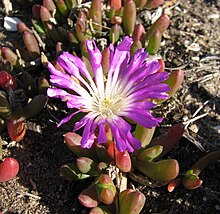Disphyma crassifolium subsp. clavellatum
| Disphyma crassifolium subsp. clavellatum | |
|---|---|

| |
| Scientific classification | |
| Kingdom: | Plantae |
| Clade: | Tracheophytes |
| Clade: | Angiosperms |
| Clade: | Eudicots |
| Order: | Caryophyllales |
| Family: | Aizoaceae |
| Genus: | Disphyma |
| Species: | |
| Subspecies: | D. c. subsp. clavellatum
|
| Trinomial name | |
| Disphyma crassifolium subsp. clavellatum | |
Disphyma crassifolium subsp. clavellatum is the subspecies of Disphyma crassifolium (round-leaved pigface) that occurs in Australia and New Zealand. It is sometimes known by the common name rounded noon-flower[1]
Also called "karkalla" in the Australian native foods trade. However, this name originally only described Carpobrotus rossii and has been misapplied to D.crassifolium as a vegetable.[2]
Description
It grows as a prostrate, succulent shrub or annual herb, from two to 30 centimetres high. Unlike the other pigfaces its leaves are round in cross-section. Flowers are pink, purple or violet.[3]
Taxonomy
This subspecies was first published under the name Mesembryanthemum australe by Georg Forster in 1786, based on New Zealand material. Forster failed to give a description, however, so valid publication of the name falls to William Aiton, who published a description in 1789.[4] In 1803, Adrian Hardy Haworth published M. clavellatum based on plants raised at Kew from seeds collected in Australia.[5] In 1830, N. E. Brown transferred M. australe into Disphyma as D. australe.[6] In 1971 Robert Chinnock published a new species name, D. blackii, for some New Zealand material,[7] and five years later he transferred M. clavellatum to Disphyma.[8]
In the early 1980s,
Distribution and habitat
Disphyma crassifolium is widely distributed in Australia and New Zealand. It grows in saline areas such as coastal dunes and samphire flats, and tolerates a range of soils including sand, loam and clay.[3]
Uses
The leaves have become a popular native vegetable in Australia marketed under the name "karkalla". It typically has a salty flavour and can be used fresh or as a pickled ingredient.[12]
References
- ^ "Rounded Noon-flower". Victorian Resources Online. Department of Primary Industries (Victoria). Archived from the original on 2008-07-31. Retrieved 2008-05-31.
- ^ "Karkalla".
- ^ Department of Biodiversity, Conservation and Attractions.
- ^ "Mesembryanthemum australe Aiton". Australian Plant Name Index (APNI), IBIS database. Centre for Plant Biodiversity Research, Australian Government.
- ^ "Mesembryanthemum clavellatum Haw". Australian Plant Name Index (APNI), IBIS database. Centre for Plant Biodiversity Research, Australian Government.
- ^ "Disphyma australe (Aiton) N.E.Br". Australian Plant Name Index (APNI), IBIS database. Centre for Plant Biodiversity Research, Australian Government.
- ^ "Disphyma blackii Chinnock". Australian Plant Name Index (APNI), IBIS database. Centre for Plant Biodiversity Research, Australian Government.
- ^ "Disphyma clavellatum (Haw.) Chinnock". Australian Plant Name Index (APNI), IBIS database. Centre for Plant Biodiversity Research, Australian Government.
- ^ Prescott, A.; Venning, J. (1984). "Aizoaceae". Flora of Australia, Volume 4: Phytolaccaceae to Chenopodiaceae. Canberra: Australian Government Publishing Service.
- ^ "Disphyma crassifolium subsp. clavellatum (Haw.) Chinnock". Australian Plant Name Index (APNI), IBIS database. Centre for Plant Biodiversity Research, Australian Government.
- ^ "Disphyma crassifolium subsp. crassifolium (Haw.) Chinnock". Australian Plant Name Index (APNI), IBIS database. Centre for Plant Biodiversity Research, Australian Government. [sic]
- ^ "What is karkalla?".
